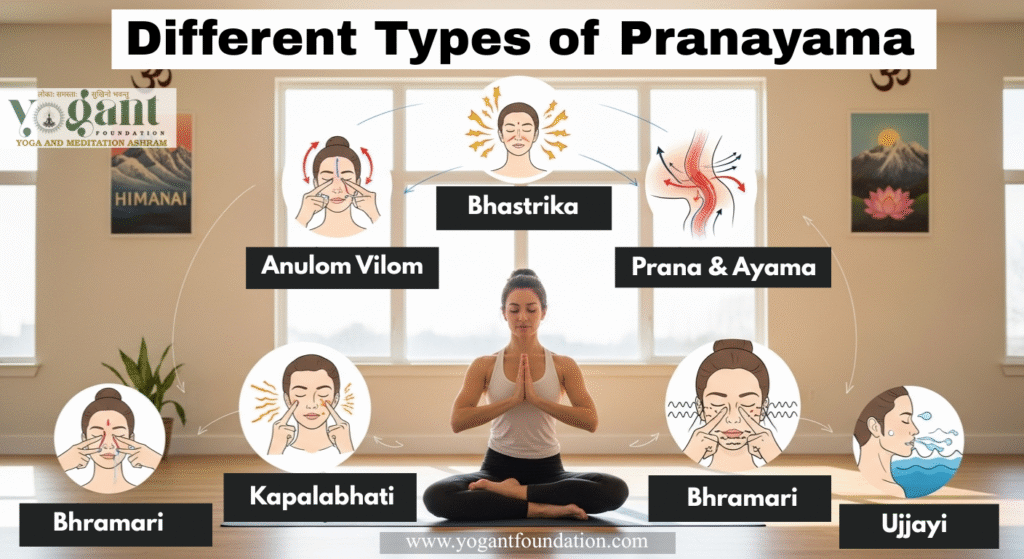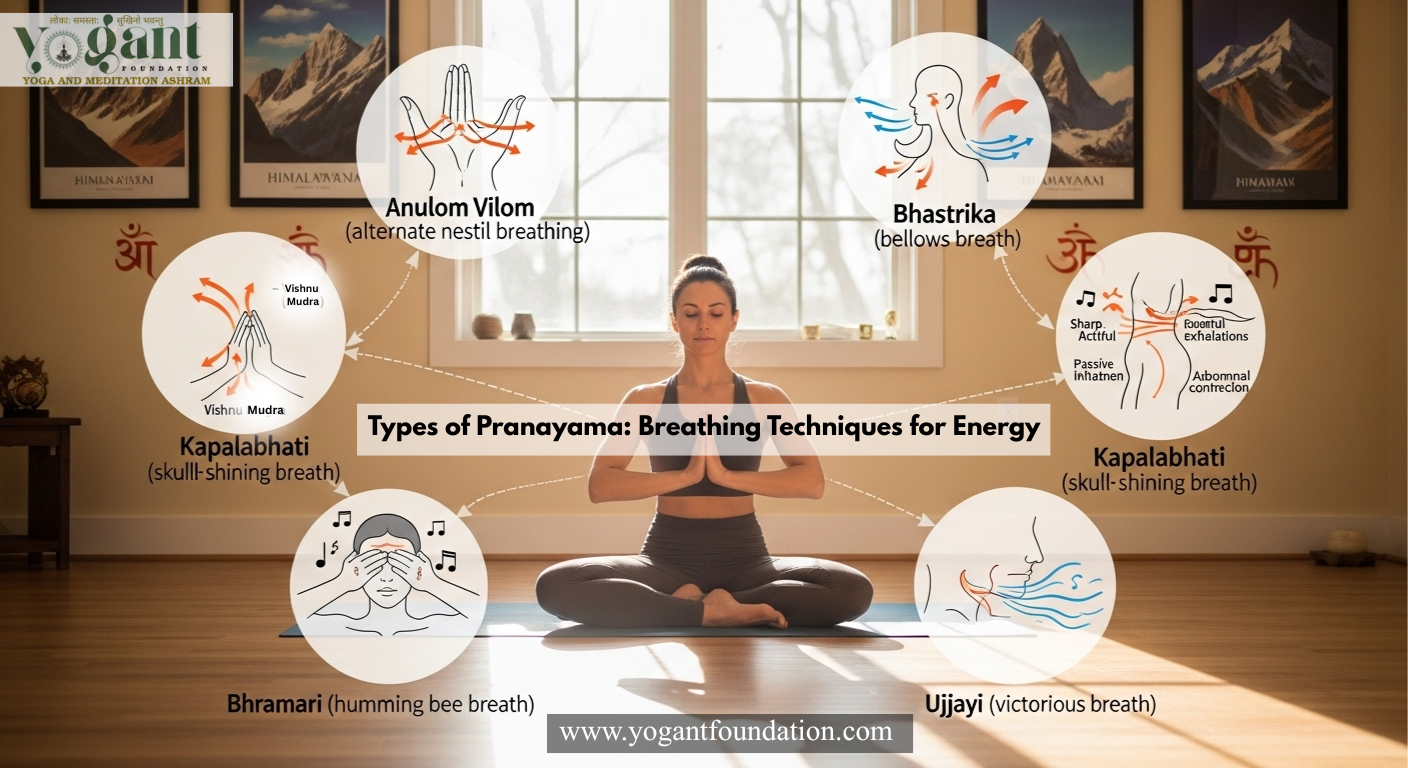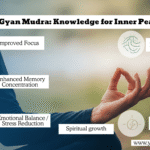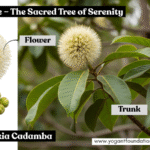Introduction – Types of Pranayama
Life is breath. Yoga breath goes beyond inhaling or exhaling. It is the link between body, soul, and mind. This is known as Pranayama. It is composed of two Sanskrit phrases – Ayama, which means extension or control. Pranayama of different types helps to balance the energy channels in our body, improves overall health, and calms the mind. No matter if you’re starting or are an advanced yogi, knowing the different types of Pranayama will help you connect with yourself and improve your yoga journey.
Top 7 types of pranayama and More
1. Nadi Shodhana (Alternate Nostril Breathing)
Meaning
Nadishodhana means “purification and balance of energy channels”. This Pranayama is used to bring the Prana into equilibrium through the Ida(moon) and Pingala (“sun”) nadis.
How to Practice
- Seated comfortably, spine straight.
- Close the right nostril using your thumb, and breathe through your left.
- Close your left nostril, and breathe out through your right.
- Repeat this alternate for 10 rounds.
Benefits
- Balances both the left- and right-brain hemispheres.
- Relieves anxiety and stress
- Increases mental clarity and stability.
2. Bhastrika Pranayama (Bellows Breath)
Meaning
Bhastrika literally means “bellows,” and represents the powerful rhythmic breath that is energizing to your body.
How to Practice
- Sit with your legs crossed.
- Breathe in deeply, then exhale strongly through the nose.
- Continue to breathe in and out quickly, for 10-20 seconds.
Benefits
- Increases lung capacity.
- Increases energy and calms the brain.
- Strengthening the respiratory and nervous systems
3. Sheetali Pranayama (Cooling Breath)
Meaning
The word “cool” is derived from Sheetal. It cools down the body while calming the mind.
How to Practice
- As you sit, roll your mouth like a tubular.
- As you breathe in, feel the air cooling your mouth.
- Close your lips and slowly exhale through your nose.
Benefits
- The body’s heat will be reduced.
- Stress and high blood pressure are reduced.
- This soothing agent soothes tension and anger.
4. Sheetkari Pranayama (Hissing Breath)
Meaning
Breathing through your teeth produces a hissing-like sound.
How to Practice
- You can clench your teeth gently and sit comfortably.
- Making a sound of “ssss”, inhale by using your teeth.
- Breathe slowly out through the nose.
Benefits
- Calms the nervous system
- Improves digestion.
- It brings calmness and inner peace.
5. Kapalabhati Pranayama (Skull Shining Breath)
Meaning
Kapalabhati literally means “shining head.” This is a method of cleansing that eliminates toxins from the brain and gives it a boost.
How to Practice
- Settle up and inhale deeply.
- Constrain your abdominal muscles to forcefully exhale by squeezing through the nostrils.
- Allow inhalation to occur after every exhalation.
Benefits
- It detoxifies the lungs and the sinuses.
- Increases alertness and focus.
- Increases metabolic rate and helps with weight loss
6. Bhramari Pranayama (Humming Bee Breath)
Meaning
Bhramari translates to “bee”. The sound that is made during practice resembles a bee humming, and soothes your mind.
How to Practice
- You can use your fingers to cover your eyes and ears.
- Take a long, deep inhale and then exhale while making a low humming noise.
- Repeat for 5-10 rounds.
Benefits
- It relieves stress, anxiety, and anger.
- Enhances memory and concentration.
- Brings deep mental relaxation.
7. Surya Bhedana Pranayama (Right Nostril Breathing)
Meaning
The Surya technique is used to activate the Pingala nadi – the solar energy channel.
How to Practice
- Close your left nostril while inhaling through the right.
- Exhale using the left nostril.
- Repeat for 10 rounds.
Benefits
- The body’s heat and energy levels are elevated.
- Improves digestion.
- It helps to overcome depression and fatigue.
8. Chandra Bhedana Pranayama (Left Nostril Breathing)
Meaning
This breath practice is called Chandra and activates the Ida Nadi. It brings calmness, cooling.
How to practice
- Inhale from the left nostril after closing your right nostril.
- You can exhale by using the nostril on your right.
- Repeat the process 10-15 times.
Benefits
- Calms down the mind.
- Relieves stress and anger
- Sleep well with this product.
9. Anulom Vilom Pranayama (Alternate Nostril Breathing Variation)
Meaning
Nadi shodhana is a popular and simpler variation.
How to practice
- Inhale by closing the right nostril and inhaling through the left.
- Close your left nostril and breathe out through the right.
- Take a deep breath in through your right nostril and exhale out through your left.
- Continue the 5-10 minute session.
Benefits
- Balance Apana and Prana energies.
- Improvements in respiratory health
- Harmony and inner balance are achieved.
10. Ujjayi Pranayama (Ocean Breath)
Meaning
Ujjayi translates to “victorious.”
How to practice
- While slightly constricting your throat, inhale deeply while holding your nostrils.
- As you breathe out, maintain the same tightening of the nasal passage.
- Listen for the hissing sounds.
Benefits
- Enhances focus during meditation.
- Calms mind and body
- Oxygen supply is increased and endurance improved.

How to Choose the Right Type of Pranayama
Every Pranayama serves a unique purpose. Others are meant to calm you down. Beginners can start by doing Anulom Vilom or Bhramari. More advanced practitioners may want to try Kapalabhati and Bhastrika. It is important to practice only under the guidance of an expert, particularly if your health condition requires it.
Benefits of Practicing Different Types of Pranayama
- Oxygen flow and lung capacities are improved.
- Relieves anxiety and depression.
- It balances hormones and increases immunity.
- Promoting mindfulness and inner calm.
- It supports meditation and spiritual awakening.
FAQ on types of Pranayama
1. What are the different types of Pranayama?
Around 10 types of traditional dances are available, such as Nadi-Shodhana (also known as Nadi Shodhana), Kapalabhati (also known by the name Kapalabhati), Bhastrika (also called Bhramari), Sheetali, and Sheetkari.
2. What types of Pranayama would be best for beginners to learn?
Anulom Vilom and Bhramari are the best choices for beginners, as they are simple and gentle.
3. What Pranayamas increase energy?
Bhastrika and Kapalabhati both have energizing effects that awaken and boost the oxygen levels in your body.
4. What Pranayamas help to cool the body?
The cooling Pranayamas Sheetkari and Sheetali help to reduce stress and heat.
5. Can I do Pranayama daily?
Pranayama is something that can be practiced daily. It’s best to do it in the morning, on an empty stomach, for maximum benefit.
Precautions on types of Pranayama
- Do not practice on an empty tummy.
- You should avoid forceful techniques if you feel unwell or are pregnant.
- Breathe naturally and never force yourself to breath.
- You should stop if your dizziness or discomfort increases.
Conclusion
Pranayama is more than just breathing. It is the gateway to physical vitality and emotional balance, as well as spiritual growth. Pranayama is a way to awaken the inner power and harmony of your being.
You can find a Pranayama that will help you achieve your goals, be it calmness or focus. Experience the magic of conscious breathing by starting your journey now.



